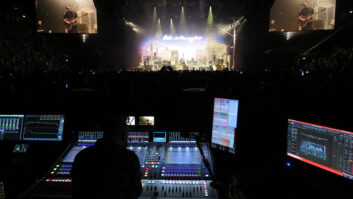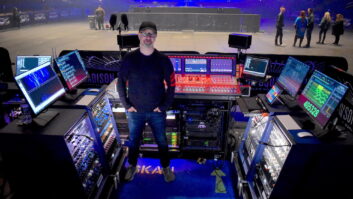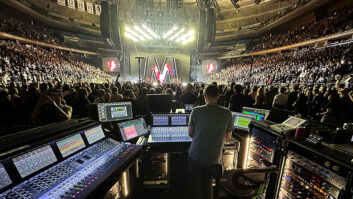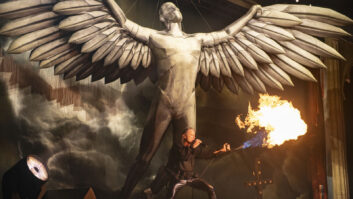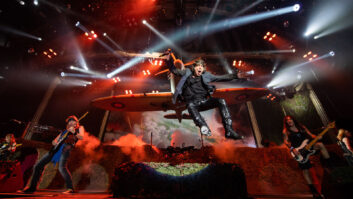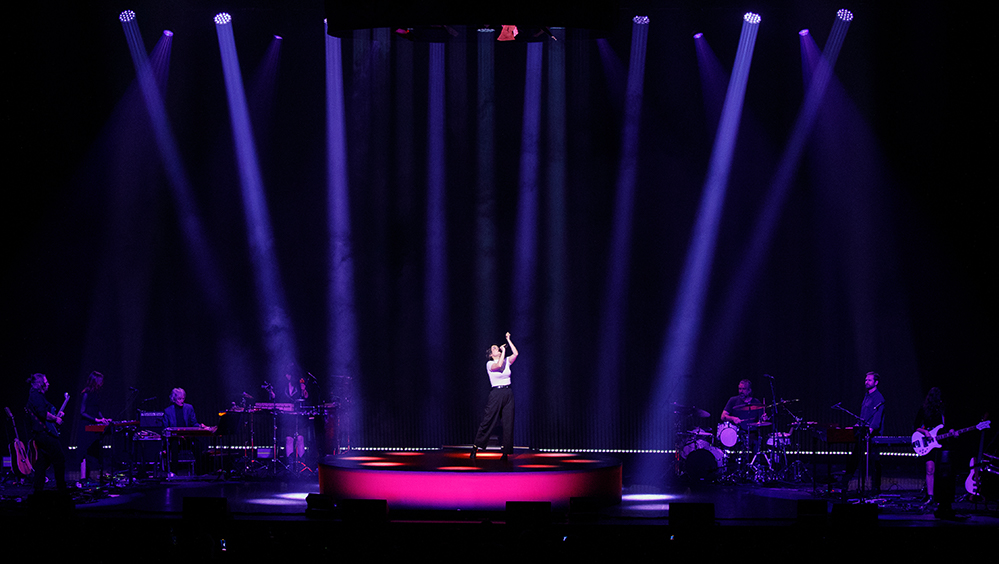
New York, NY (April 2, 2024)—A melodic, multi-genre presence on the indie rock scene for more than a decade, singer/songwriter Mitski is on the road touring behind 2023’s The Land Is Inhospitable and So Are We album—and it’s a journey that has become as unconventional as her music. Originally envisioned as a simple string of 19 large-theater dates in 12 cities, the jaunt has nearly doubled in size, expanding to 36 concerts after performances kept selling out.
“Whenever they announce shows, tickets go pretty quickly and they add more, which turns it from a tour into a series of residencies,” said FOH engineer Patrick Scott. Case in point: He was speaking before the sixth of seven New York City shows in eight days, with four at Manhattan’s Beacon Theatre and another three at Brooklyn’s Kings Theatre.
“It’s helpful being in the same space for a while,” added monitor engineer Ashoka Kanungo. “We get to really nail it. I think the biggest challenge initially was load-ins and load-outs, just getting into that rhythm of what needs to happen, because you camp out for a few days and you forget, but we got it down quickly.”
While venues on the tour range from 2,500- to 6,000-plus seats, each concert finds the artist pulling the audience in close, drawing it into the drama of the music—a vibe created through radical new song arrangements that are then bolstered by Scott’s work at front-of-house.
“Mitski wanted to do more of a theatrical, seated, intimate show,” said Scott. “One of the big draws is that everyone connects with the lyrics, and with Mitski’s voice and personality. A big part of it for me, then, is to make it feel like she’s speaking to them, and that affects the way I mix—for instance, how I treat compression and EQ. I keep the vocal front and center, but also let the band show off because they’re all incredibly talented players. As a unit, there’s something pretty special about what they’re doing.
“A lot of the older songs have been rearranged to fit into the instrumentation of the last record,” he explained. “Where there might have been a lot more synthesizers or drum machines before, now there’s auxiliary percussion, B3 organ, fiddle, acoustic guitars, instruments like that. The aesthetic that’s happening is definitely a more timeless feeling—a lot warmer, more analog, more acoustic. I want to convey that feel, but in a way where the people who are coming to the show can still connect with the songs that they know.”
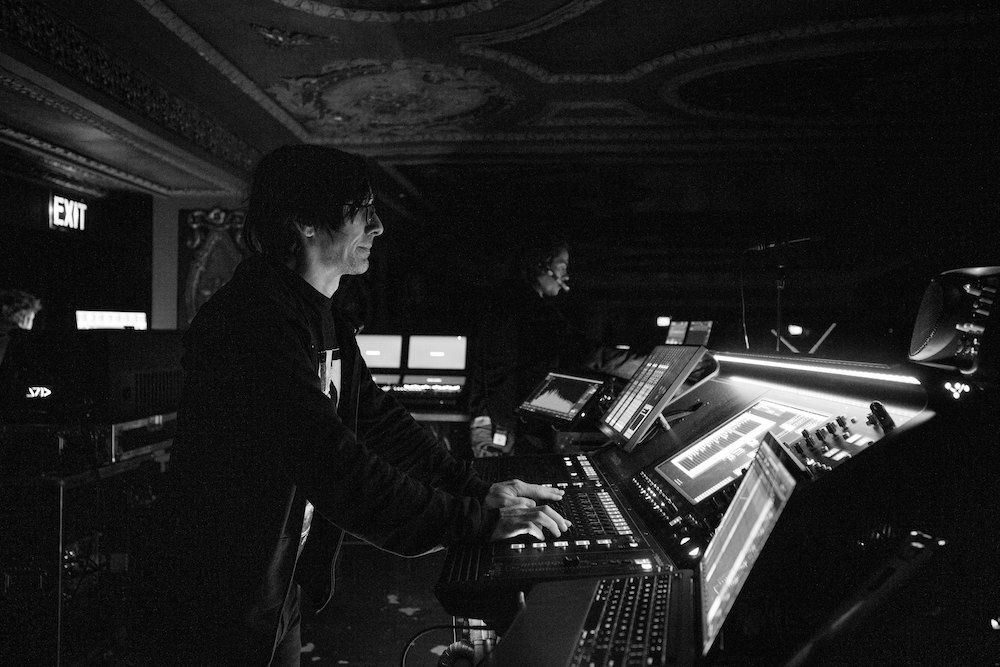
The audio team’s tools for making that connection—all provided by Nashville-based Worley Sound—center around DiGiCo Quantum 225 consoles at both FOH and monitor mix positions, adjoined by SD racks with 32-bit cards. Both engineers opt for onboard effects or outboard rack gear. “I tend to not do too much with plug-ins,” said Kanungo. “I think it adds in a lot of latency, especially for in-ears.”
Likewise, both engineers use Rupert Neve Designs 5045 Primary Source Enhancers on Mitski’s vocal, with Scott additionally running the result through an Empirical Labs Distressor.
Also in the racks at FOH is a Handsome Audio Zulu passive analog tape simulator, used on all acoustic guitars. “It’s a bit more of a studio piece,” Scott admitted. “One of the benefits of having a musical director on the tour who also produces most of Mitski’s records, is that he’s a bit of a studio nerd, so we get into the nitty gritty on that stuff and some studio pieces find their way into the live setup. The Zulu is pretty magical—I really like what it does for my DI’d acoustic guitars; it takes a bit of the edge off of them and warms them up.”
A band bus feeds into an Empirical Labs Fatso to gently congeal things together, and similarly, the master bus leads into a Rupert Neve Designs Master Buss Processor, he said: “It connects the band bus with where the vocal is sitting and makes it all feel like it’s happening in the same space.”
The musicians performing in that same space onstage hear Kanungo’s monitor mixes via Shure PSM 1000 wireless packs and a variety of JH Audio in-ear monitors, with everyone on JH16s except Mitski and the musical director who opted for Roxannes.
“There’s eight people, so there’s always going to be a couple of interesting mixes,” she said. “Some people just want to hear what they’re playing or whatever they’re cueing off of, but then others want a totally balanced mix where they can hear everything. It’s great being on the Quantum 225, because I’m able to EQ things differently, compress things differently for people, and that’s been such a game changer.”
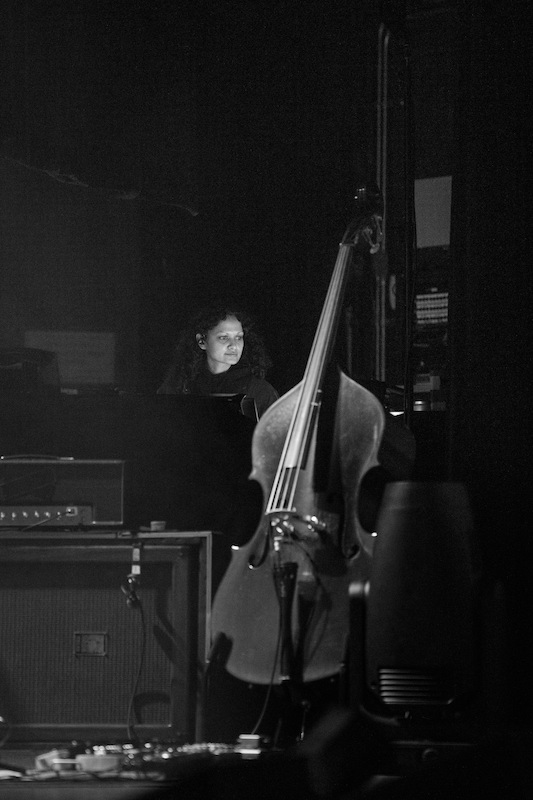
Also at the monitor mix position is a Shure AXT600 Axient Spectrum Manager and two channels of Axient wireless mics for Mitski, each outfitted with an Austrian Audio OD505 WL1 mic capsule. “Tom Worley put us on to the OD505 for Mitski’s vocal, which neither of us had ever used,” said Kanungo. “We decided to try it because he said the rejection was great; we did a shoot-out in rehearsals, and it’s true. The rejection is amazing while also still being smooth as can be.”
Many of the microphones in use are owned by the bandmembers themselves, so there’s rarely seen choices like Josephson e22 side-address cardioid condensers used on the snare top and the pedal steel. Radial JDI boxes are dotted around the stage, while acoustic instruments go through a mixture of Radial PZ-Pre and PZPro preamp/DIs. The bass DI setup, however, is slightly unorthodox, with a Black Tape Wiretap unit placed between the amplifier and DI to provide the amp sound as well as the sound of the instrument itself.
‘Behind The Wheel’ of Depeche Mode’s Memento Mori World Tour
Elsewhere, the electric guitar and pedal steel amps are in ISO cabinets, and a Leslie speaker is kept on the sidelines, so between them, the DIs and the in-ears, it’s a relatively quiet stage—which is crucial for conveying Mitski’s vocals. “Mitski is a really dynamic singer,” said Scott. “She can go from whisper-quiet to full-diaphragm singing in the same song, so keeping the whisper-quiet parts clear and above everything while there’s drums getting leaned into three feet away from her is probably one of the bigger challenges. A lot of it is about finding the space for everything so that the detail is there. Every instrument has a different role in every song, so it’s a matter of listening and considering where to put them in the mix, so that it all supports what Mitski is doing with her voice.”
While the current tour leg and a spring European run have the singer and her band working their intimate magic in large theaters, another U.S. leg starting in late summer will add amphitheaters into the mix, culminating with a show at the 17,500-seat Hollywood Bowl. The land may be inhospitable, but they’ll be covering a lot of it this year.
